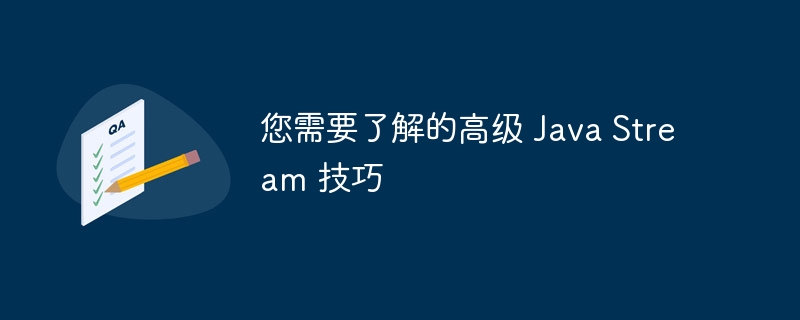您需要了解的高级 Java Stream 技巧
来源:dev.to
时间:2024-11-18 11:03:54 489浏览 收藏
怎么入门文章编程?需要学习哪些知识点?这是新手们刚接触编程时常见的问题;下面golang学习网就来给大家整理分享一些知识点,希望能够给初学者一些帮助。本篇文章就来介绍《您需要了解的高级 Java Stream 技巧》,涉及到,有需要的可以收藏一下

1. 创建映射来缓存实体
在 map 中缓存实体可以通过减少从数据库或其他数据源重复获取数据的需要来提高性能。使用java streams,您可以轻松创建这样的缓存。
示例代码
import java.util.list;
import java.util.map;
import java.util.stream.collectors;
class user {
private int id;
private string name;
// constructors, getters, setters
}
public class entitycacheexample {
public static void main(string[] args) {
list<user> users = list.of(
new user(1, "alice"),
new user(2, "bob"),
new user(3, "charlie")
);
map<integer, user> usercache = users.stream()
.collect(collectors.tomap(user::getid, user -> user));
system.out.println(usercache);
}
}
在上面的代码中,我们使用 collectors.tomap() 将 user 对象列表转换为 map,其中键是用户的 id,值是 user 对象本身。这有效地创建了用户实体的缓存。
演示结果
{1=user{id=1, name='alice'}, 2=user{id=2, name='bob'}, 3=user{id=3, name='charlie'}}
2. 创建嵌套映射
当您需要将数据分类为多个级别时,嵌套映射非常有用。例如,您可能希望按部门然后按角色对用户进行分组。
示例代码
import java.util.list;
import java.util.map;
import java.util.stream.collectors;
class user {
private string department;
private string role;
private string name;
// constructors, getters, setters
}
public class nestedmapexample {
public static void main(string[] args) {
list<user> users = list.of(
new user("hr", "manager", "alice"),
new user("it", "developer", "bob"),
new user("it", "manager", "charlie")
);
map<string, map<string, list<user>>> nestedmap = users.stream()
.collect(collectors.groupingby(user::getdepartment,
collectors.groupingby(user::getrole)));
system.out.println(nestedmap);
}
}
此代码演示了如何使用 collectors.groupingby() 创建嵌套 map。外部 map 按部门对用户进行分组,而内部 map 进一步按角色对用户进行分组。
演示结果
{hr={manager=[user{name='alice'}]}, it={developer=[user{name='bob'}], manager=[user{name='charlie'}]}}
3. 创建具有两个值的映射
有时,您可能希望在 map 中存储单个键的多个属性。使用地图
>
可能是一个有效的解决方案。
示例代码
import java.util.list;
import java.util.map;
import java.util.abstractmap.simpleentry;
import java.util.stream.collectors;
class user {
private int id;
private string name;
private int age;
// constructors, getters, setters
}
public class mapwithtwovaluesexample {
public static void main(string[] args) {
list<user> users = list.of(
new user(1, "alice", 30),
new user(2, "bob", 25),
new user(3, "charlie", 35)
);
map<integer, map.entry<string, integer>> usermap = users.stream()
.collect(collectors.tomap(user::getid, user ->
new simpleentry<>(user.getname(), user.getage())));
system.out.println(usermap);
}
}
在这里,我们使用 simpleentry 创建一个 map,其中包含与每个用户 id 关联的两个值(姓名和年龄)。
演示结果
{1=alice=30, 2=bob=25, 3=charlie=35}
4. 分组依据和映射
分组和映射在一起可以简化复杂的数据转换,例如将对象列表转换为分组的map,其中每个组包含特定属性。
示例代码
import java.util.list;
import java.util.map;
import java.util.stream.collectors;
class user {
private string department;
private string name;
// constructors, getters, setters
}
public class groupingbymappingexample {
public static void main(string[] args) {
list<user> users = list.of(
new user("hr", "alice"),
new user("it", "bob"),
new user("hr", "charlie")
);
map<string, list<string>> groupedmap = users.stream()
.collect(collectors.groupingby(user::getdepartment,
collectors.mapping(user::getname, collectors.tolist())));
system.out.println(groupedmap);
}
}
在此示例中,我们按部门对用户进行分组,然后将 user 对象映射到他们的名称,创建一个 map,其中每个部门与名称列表相关联。
演示结果
{hr=[alice, charlie], it=[bob]}
5. 分组依据、映射和归约
结合分组、映射和归约可以让您有效地聚合数据,例如对值求和或查找每个组中的最大值。
示例代码
import java.util.list;
import java.util.map;
import java.util.stream.collectors;
class transaction {
private string type;
private int amount;
// constructors, getters, setters
}
public class groupingbymappingreducingexample {
public static void main(string[] args) {
list<transaction> transactions = list.of(
new transaction("deposit", 100),
new transaction("deposit", 200),
new transaction("withdrawal", 50),
new transaction("withdrawal", 30)
);
map<string, integer> transactionsums = transactions.stream()
.collect(collectors.groupingby(transaction::gettype,
collectors.reducing(0, transaction::getamount, integer::sum)));
system.out.println(transactionsums);
}
}
在此代码中,我们按类型对交易进行分组,将它们映射到其金额,然后通过求和来减少金额。结果是一个显示每种交易类型总金额的地图。
演示结果
{Deposit=300, Withdrawal=80}
六、结论
这些高级 java stream 技巧可以显着提高您的编码效率和可读性。通过掌握这些技术,您可以轻松处理复杂的数据处理任务。如果您有任何疑问或需要进一步说明,请随时在下面发表评论!
阅读更多帖子:您需要了解的 5 个高级 java stream 技巧
到这里,我们也就讲完了《您需要了解的高级 Java Stream 技巧》的内容了。个人认为,基础知识的学习和巩固,是为了更好的将其运用到项目中,欢迎关注golang学习网公众号,带你了解更多关于的知识点!
-
501 收藏
-
501 收藏
-
501 收藏
-
501 收藏
-
501 收藏
-
326 收藏
-
252 收藏
-
337 收藏
-
259 收藏
-
298 收藏
-
106 收藏
-
490 收藏
-
328 收藏
-
275 收藏
-
422 收藏
-
152 收藏
-
229 收藏
-

- 前端进阶之JavaScript设计模式
- 设计模式是开发人员在软件开发过程中面临一般问题时的解决方案,代表了最佳的实践。本课程的主打内容包括JS常见设计模式以及具体应用场景,打造一站式知识长龙服务,适合有JS基础的同学学习。
- 立即学习 543次学习
-

- GO语言核心编程课程
- 本课程采用真实案例,全面具体可落地,从理论到实践,一步一步将GO核心编程技术、编程思想、底层实现融会贯通,使学习者贴近时代脉搏,做IT互联网时代的弄潮儿。
- 立即学习 516次学习
-

- 简单聊聊mysql8与网络通信
- 如有问题加微信:Le-studyg;在课程中,我们将首先介绍MySQL8的新特性,包括性能优化、安全增强、新数据类型等,帮助学生快速熟悉MySQL8的最新功能。接着,我们将深入解析MySQL的网络通信机制,包括协议、连接管理、数据传输等,让
- 立即学习 500次学习
-

- JavaScript正则表达式基础与实战
- 在任何一门编程语言中,正则表达式,都是一项重要的知识,它提供了高效的字符串匹配与捕获机制,可以极大的简化程序设计。
- 立即学习 487次学习
-

- 从零制作响应式网站—Grid布局
- 本系列教程将展示从零制作一个假想的网络科技公司官网,分为导航,轮播,关于我们,成功案例,服务流程,团队介绍,数据部分,公司动态,底部信息等内容区块。网站整体采用CSSGrid布局,支持响应式,有流畅过渡和展现动画。
- 立即学习 485次学习
